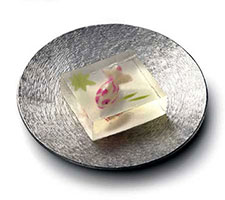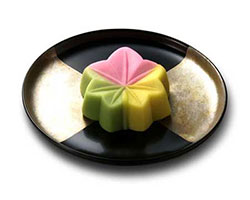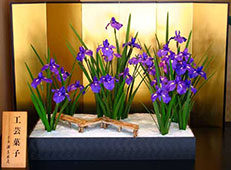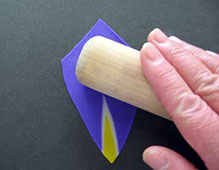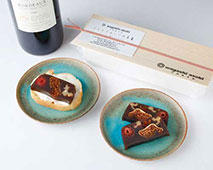Web Japan > Trends in Japan > Pop Culture > Wagashi
WAGASHI
Developing the "Art of the 5 Senses."

Traditional Japanese Wagashi – including kinton (front left in photograph) with its colors that change by the season
Wagashi are traditional Japanese cakes known also as “art of the five senses.” With their beautiful design, delicate sweetness and pleasant taste, they offer layer-upon-layer of enjoyment. One by one, each little cake sets a seasonal scene - fish swimming in a clear stream; an atrium of stars shining in the night sky; a sparkling, sunlit shore and so on. While the skill of wagashi craftsmen has been handed down throughout the ages and is much cherished, wagashi have also risen to provide shining examples of new challenges, undaunted by changing eras and preferences. Incorporating techniques and ingredients from Western cake-making has proved a breath of fresh air in the creation of new wagashi and inspired further development of the craft.
Motifs Displaying Scenes from Nature
Left: Kingyokukan - made by melting agar, adding sugar and syrup, melting down and pouring into a mold. It looks like the goldfish is swimming around in different areas, in and out of the shadow of the green leaves floating on the water's surface.
© Toraya Corp.
Right: Like the autumn leaves changing color, this cake called konashi turns from green, to yellow and on to red © Toraya Corp.
Traditional wagashi are made from very simple ingredients - sugar, grains, agar and fruit. Wagashi started out as rustic sweetmeats, such as rice cakes and dumplings made from kneaded flour. But the impact of trade with China, Portugal, and Spain etc., and the fusion of wagashi into the culture of sado (tea ceremony) have led to their current sophisticated form. A characteristic feature of wagashi is how they represent in miniature the seasons and natural motifs such as transitory flowers and grass, mountain streams, or the universe.
For example, kinton is a type of wagashi made of fluffed up, minced sweet bean paste “an” which uses adzuki (small beans) or kidney beans and its color changes with the seasons. At New Year we think of fresh new shoots sprouting from the snow, an effect created by daubing the wagashi with white and green an; while in early spring our hearts leap at the sight of the vivid crimson ume (Japanese plum) blossoms that foretell the coming of spring. By daring to use the bellflower ahead of its autumn season, we can lure a refreshing sense of coolness in the height of summer; and in November we can create winter with a dusting of white sugar powder.
It is not only scenes from nature that provide the motifs for wagashi. They are created around many themes such as the seasonal utterances of haiku, a form of literature born in Japan; or classical literature, historic sites and so on. Chatting about the hidden background and anecdotes that lie behind the creation, while admiring its beauty, is one of the many ways to enjoy wagashi.
Top Rate Craftsmanship
Left: Irises made from wagashi, displayed as Kogei gashi (cake art)
© Soke Minamoto Kitchoan Corp.
Right: Tools are used to make the wagashi petals one by one © Soke Minamoto Kitchoan Corp.
There are said to be around 80,000 wagashi artisans in Japan. From their ranks are born master craftsmen who combine both creativity and technical skills, not only in terms of taste, but also with finely honed know-how and excellence in areas such as design, coloring and decoration etc. These seasoned craftsmen make full use of traditional skills to create products known as kogei gashi (cake art). The workmanship may well be labeled as art. It uses specialist tools to sculpt landscapes of the four seasons made with basic wagashi ingredients such as white bean paste, sugar and glutinous rice flour; stunning representations that depict subtle shades of color in each petal and leaf!

Just like real sushi no matter how you look at them, but sweet when you taste them © Wagashi Tsukasa Izumiya
Enlarge photoThere are unique sushi made entirely of wagashi ingredients, which are amazing to see and so elaborately made that when placed on the counter in a sushi bar they will fool the customer into taking a bite.
The tuna that tops the sushi is made of sweet red bean jelly with the taste of ume; the conger eel uses soybean flour with syrup made from boiled down brown sugar which is disguised as tare sauce. It looks like sushi, but tastes of sweet wagashi when eaten; a contradiction opens up a world of mystery.
Breaking the Bounds of Tradition
As healthy cakes made only from low-calorie ingredients such as red beans and rice flour, wagashi have long been counter-products to western cakes made from cream and butter. But recent years have seen many cakes that cross the boundaries of both, combining the methods and traditional ingredients of both wagashi and western cakes.
Left: Yokan made with dried fruit goes well with sliced bread and wine too
© MIHO
Right: Sliced lemon is rare in wagashi, but put it in agar and it stands out like lace © Daigokudenhonpo
There are also long-standing wagashi created with a respect for tradition such as yokan (sweet bean jelly) using rum and dried fruits which is a great accompaniment to coffee and wine; and lace loaf which is agar with lemon in it; an ingredient rarely used in wagashi. Traditional wagashi used in the tea ceremony were often subtle in taste and aroma and did not use the different types of berries and highly acidic citrus fruits used in western cakes. However, in recent years wagashi have been created using western cake ingredients such as apricots and pears.
On the other hand there are also many examples of wagashi methods influencing western cakes. There have even been pâtissiers in France making chocolate flavored with yuzu (an Asiatic citrus fruit), sesame and wasabi (Japanese horseradish); Mont Blanc made with green tea and red beans; and macaroons made with brown rice tea etc. Recently we have also seen an increase in foreigners coming here to Japanese pâtisserie schools to learn how to make wagashi.
It is fun to be able to savor the spirit of craftsmen who are not afraid to combine elements of differing natures in the ever-changing wagashi.
(October 2013)
- Ekiben: Train Bento Boxes (March 2013)

